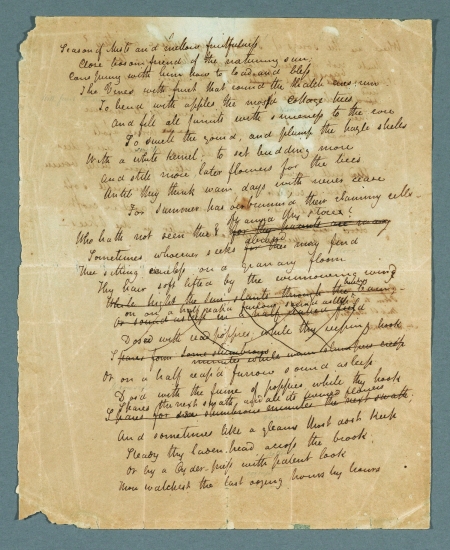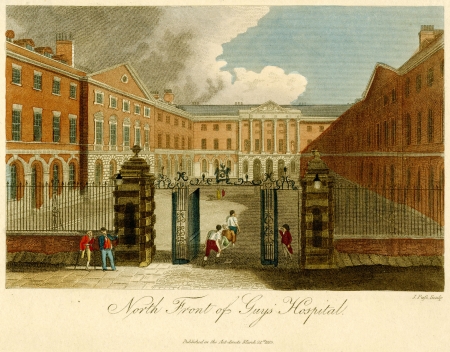
Harvard's John Keats Collection — which began in 1915 with a souvenir snippet of lines from “I stood tip-toe” in the autograph album of Boston publisher James T. Fields — has grown to the largest collection of Keats manuscript material in the world.

The Houghton Library collection preserves nearly three-quarters of Keats's surviving autograph poetry — poetry handwritten by the poet himself. With 86 autograph and 24 unique transcript letters, it's also the largest single collection of Keats’s letters.
The Harvard Keats Collection grew almost entirely through gifts. The defining gift was that of Amy Lowell in 1925. Lowell — poet, philanthropist, and eventual biographer of Keats — amassed the largest Keats collection in private hands, including such treasures as:
- the rough first draft of The Eve of St. Agnes, which Lowell said taught her “more about writing poetry than anything else in the world";
- the manuscripts of On First Looking into Chapman’s Homer and To Autumn; and
- many letters by Keats to his publishers Taylor and Hessey, and to the young woman he loved, Fanny Brawne.
If Lowell defined the collection, it was Arthur A. Houghton, Jr. who transformed it from a “collector’s collection” into a world-class research collection.
Houghton began collecting Keats in 1929, shortly after his graduation from Harvard. His gift of funds to build the Houghton Library, and within it the Keats Room, was the catalyst for great growth in the Harvard Keats Collection.
Houghton’s gifts included:
- the Crewe Collection, collected by Richard Monckton Milnes in the preparation of his Life, Letters, and Literary Remains of John Keats;
- the family papers of Keats’s sister, Fanny Keats Llanos;
- voluminous material to and by Keats’s friends, including letters and important contemporary transcripts of Keats’s poetry by Richard Woodhouse, Charles Brown, and others;
- numerous presentation copies of Keats’s published works; and
- books from the poet’s library, including his annotated copy of The dramatic works of William Shakspeare.

Other New Englanders’ collections, attracted by the collections of Lowell and Houghton, have come to enrich the holdings at Harvard.
Louis Holman’s collection of Keatsiana visually documents places and people associated with the poet. The comprehensive collection of editions of Keats’s works formed by the sculptor John Gregory, from the first collected Galignani edition to the latest, documents the transmissions of Keats’s poetic legacy over the generations. The journals of Keats’s friend, the artist Benjamin Robert Haydon, were presented in 1977 by Willard B. Pope in memory of his wife, Evelyn Ryan Pope.
Materials continue to be added to the collection. Recent additions include the last leaf of Keats’s 60-page journal letter to George and Georgiana Keats, a gift of Stellita Crilley in 1995, and an album of drawings by Charles Brown, Keats’s housemate, purchased in 2009 with the Amy Lowell Trust fund.
Accessing These Materials
Due to the fragility the of the original materials in this collection, researchers are required to use the available reproductions.
Primary access to digital images of Keats letters and manuscripts is available through this guide.
Permission to consult the originals must be approved in advance by Houghton Library.
Keats-Related Collections
The major manuscript and visual collections in the Harvard Keats Collection at Houghton Library are as follows:
- Benjamin Robert Haydon (1786–1846) collection of papers and miscellaneous papers
- Haydon family papers
- Louis Arthur Holman (1866–1939) collection of Keats iconography and related papers
- Arthur Amory Houghton (1906–1990) collection of manuscripts concerning Joseph Severn
- Fanny Keats (1803–1889) papers
- John Keats (1795–1821):
- John Keats collection
- John Keats miscellaneous papers and portraits
- John Keats portraits and artifacts
- Keats Family Books in the Harvard Keats Collection
- Joseph Severn (1793–1879) papers
Other individual manuscripts, such as the Severn album of drawings, drawings by Charles Brown, Oscar Wilde’s sonnet on the sale of Keats’s love letters, and manuscripts by other Romantics such as Percy Shelley and Leigh Hunt, can be found through HOLLIS by searching under the author’s name, then limiting the search to “Archive/Manuscript” or “Image” format material.
With the exception of the books annotated by Keats mentioned above, there is no separate, easily browsable list of the thousands of published works in the Keats Collection. However, all are cataloged and findable through HOLLIS.